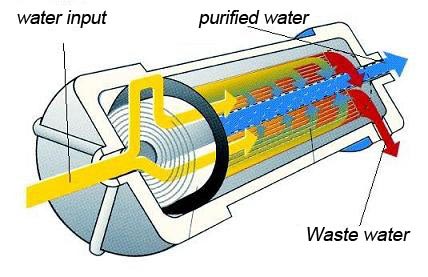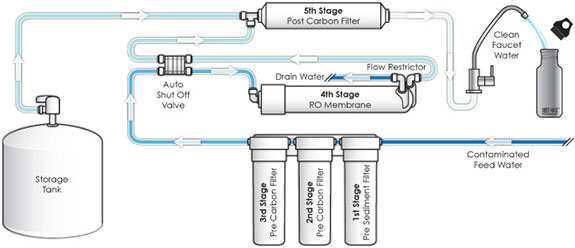A reverse osmosis system uses pressure to force water molecules through a semi permeable filter with microscopic pores that are so small they only allow the smallest molecules, like water to penetrate through. This exclusion of larger molecules, virtually removes all contaminants from the water.

A reverse osmosis for the home is typically a point of use system, usually installed under a kitchen sink, out of the way and out of site. Your home’s water supply, whether it’s from a municipality or from your own well, provides the pressure needed to operate the filter.
The pores in a reverse osmosis membrane filter are between 0.0001-0.0005 µm (one-ten-thousandth to five-ten-thousandths) of a micron in diameter, which is only very slightly larger than individual water molecules.
Using your house water pressure, water molecules are forced through these microscopic pores, leaving behind many contaminants, too large to pass through the tiny pores. This purified water or “permeate”, is then stored in a holding tank, while the water that didn’t pass through the membrane, containing the contaminants, is flushed down the drain. It’s a very efficient process.
A Residential Reverse Osmosis system is your most effective way to remove the widest range of contaminants from your drinking water.
A Home Reverse Osmosis System
A Reverse Osmosis (RO) system that is meant for your home will purify your water and is primarily used for drinking and cooking with. These units generally have of a combination of three or more filters.

Depending on the system you chose, there is usually one or two charcoal pre-filters that will filter out larger particles and chemicals from the incoming water.
The water is then sent through the RO filter which removes many many harmful contaminants.
After the water passes through the RO filter, the purified water is then sent to a pressurized holding tank, stored for when you’re ready for it.
Every RO system has at least one pre-filter (before the RO membrane) in the system. This Pre-filter is an activated carbon filter, which removes chlorine and other chemicals. Additionally, this pre-filter will help to remove particulates which would otherwise clog or foul the RO membrane filter prematurely. Some RO systems have two pre-carbon filters to do a better job of removing these larger particles.
Great, But What If I Have Well Water?
Some RO systems are specifically adapted for water coming from wells. These systems will have a better pre-filtering system, usually having two pre-filters. The first filter in these systems will be a sediment filter. The sediment filter removes larger rough particles, sand, dirt, rust, and silt. This helps keep the subsequent filters from fouling too quickly.
The second filter will be the usual carbon pre-filter, which will remove smaller particles and some chemicals, if they’re present. This extra filtering will help to ensure that the more expensive RO filter doens’t clog too soon.
Protect Your Reverse Osmosis System – Add a Sediment Filter
Any Reverse Osmosis system can be adapted for well-water use. Just add a sediment filter housing to the water supply line before it reaches your RO system. I personally have well water and that’s how I have my filtration system set up.
These whole-house sediment filter housings are available at your local hardware store for about $50. A typical replacement two-pack of sediment filters is around $12. My local hardware store stopped selling the ones I like, so I now by mine online, which are just as cheap.
As my water comes from my own well, and it has lots of silt and particulates in it during certain times of the year. During these periods, I need to change my sediment filter out frequently, sometimes once a week. Other times, I only need to change it every several weeks.
I’ve learned how to maximize these filters. By purchasing the rolled paper filters (instead of woven string type), I can score and tear off one revolution of paper, to expose new, unclogged portion of it. By doing this, I can get many weeks of use out of them!
The purified water is then stored in the holding tank after it passes through the pre-filter(s) and also passing through the RO membrane.
When someone opens the counter-top tap, the pressurized holding tank forces the stored water through yet another carbon filter. This filter is called the post-filter (after the RO membrane). It’s also known as the “polishing” filter.
This activated carbon filter removes any tastes or odors the RO water may still have. This last filter gives your drinking water a final polish, removing any lingering impure smells or tastes, and improves the efficiency of the system.
The result is pure, healthy, and fresh-tasting water, free of smells, chemicals and other contaminants!
Note: “activated carbon” – means that the carbon filter has been treated to improve its adsorption properties and filtration capacity by adding pores and cavities to the carbon material. This increases the surface area of the chemical-absorbing carbon, and greatly improves its effectiveness.
See all Reverse Osmosis at Amazon.
Visit the Water Molecule Size page for more discussion on the size of a water molecule compared to contaminant particles. This page will help you understand the best filters for filtering them.
